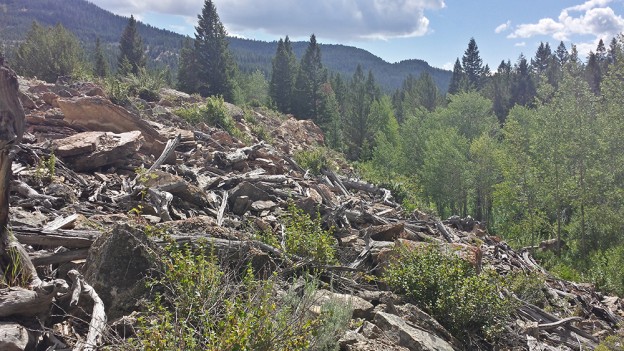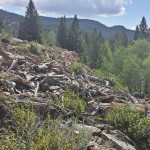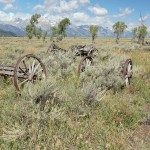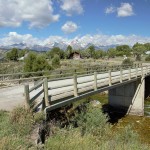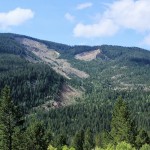- Debris left from the Sheep Mountain landslide. Photo by Samantha Ford
- Old wagon parts at Kelly. Photo by Samantha Ford
- The modern bridge at Kelly that spans the Gros Ventre River. Photo by Samantha Ford
- The scar on Sheep Mountain left by the landslide. Photo by Samantha Ford
In 1895 William “Billy” Bierer arrived in Jackson Hole to prospect for gold. He chose a site near what is now called Slide Lake, along the Gros Ventre River. After prospecting proved to be fruitless, he turned to homesteading, receiving a patent for his land in 1915. In the preceding years Bierer had spent a lot of time in the mountains behind his homestead. He reported feeling tremors in the earth along with the sound of water running under the ground. He became increasingly worried about the probability of a landslide and sold his homestead in 1920 to Guil Huff. Bierer then moved to be with his daughter in Pennsylvania, where he died in 1923. He wouldn’t live to receive the news that his prediction of a landslide would prove to be accurate.
In 1925 on June 23, 50,000,000 cubic yards of Sheep Mountain broke free and fell in a half mile-wide landslide, effectively cutting through the Gros Ventre River and rising 300 feet up on the opposite bank. Guil Huff had been out on his horse that morning inspecting more earth tremors when he looked up to see the mountain coming down on top of him. He and his horse survived the slide by a margin of 20 feet. Forney Cole and Boyd Charter happened to be in the area and witnessed the slide and Huff’s narrow escape. Without an outlet, the Gros Ventre River began rapidly rising, forming a small lake. The water continued to rise, flooding the Huff ranch and eventually submerging the property entirely under what is now known as Lower Slide Lake. Today, Lower Slide Lake is five miles long, and tops of trees that were once the valley floor can still be seen poking out above the its waters.
Cole and Charter raced their horses down the valley to assist the Huffs, all were convinced there might be more slides, and the river was quickly rising. Forest Ranger Charles Dibble was stationed at the nearby Horsetail Creek Station when the mountain fell. As it became clear the Ranger Station was also in danger of flooding, he quickly moved his family into Kelly. Days later, the Ranger Station was underwater. Others nearby reported hearing the roar of the mountain falling and seeing the cloud of dust that rose over the mountain. Miraculously, no one was injured during the landslide, despite the sudden violence of the event.
Dibble had never trusted the town’s newly formed earthen dam. The water ran through it and there were no protective spillways to prevent the water from overtopping the dam. Most constructed dams included these safety measures, as this dam was formed from landslide debris, there was no safety to speak of. A feeling of mistrust also troubled a number of Kelly residents and for months after the slide, many hauled bedding up to higher ground in fear that the dam would fail in the night. In an effort to quell these fears, and allow the town to return to normal, geologists and engineers from across the country traveled to Jackson Hole to survey the dam. They determined it not only safe, but permanent. The town of Kelly resumed normal operations and soon forgot about any danger. Ranger Dibble, however, kept a wary eye on the dam and would regularly inspect the rubble for evidence of leaks.
The winter of 1926-27 was a harsh one, with unusually high snowfall. The next spring, mountain runoff was equally severe due to heavy rains. Dibble became increasingly worried about the integrity of the dam when it became clear that the Gros Ventre River was rising; Kelly residents were having to divert broken trees from damaging their timber bridge. Dibble recognized these trees as having once been part of the debris that made up the dam. On May 18, 1927 his worst fears were confirmed when pieces of farming equipment started to come down the river, equipment that had most certainly been behind the dam structure.
Jumping into his Model T, Dibble raced up the Gros Ventre to get a firsthand look at what was unfolding upriver. He was almost immediately met with a 50 foot wall of water crashing down through the river corridor. Quickly turning around, he raced to the nearest homestead, frantically warning the occupants to call down the telephone line and warn the people in town to get out of their houses and find higher ground. Dibble raced on, stopping only to warn ranchers and to cut wires to allow livestock to flee the impending flood waters. Reaching Kelly, Dibble once again raised the alarm and residents rushed to pack up their personal belongings. Only one family in town remained, despite Dibble’s best efforts to demonstrate that they must evacuate immediately.
H.M. Kneedy and his wife, Anna were unconcerned with the activity surrounding them and obstinately refused to believe that the dam that had been declared “safe” was failing. Kneedy, his wife and his young son, Joe, would perish in the flood waters. Three others lost their lives in Kelly, unable to outrun the powerful surge of water; Maud Smith, May Lovejoy and Clint Stevens. Countless more were rescued or able to cling to trees. The residents of nearby Grovont watched the entire episode, helpless, wondering about the fate of their neighbors. They were the first rescuers to arrive on the scene, with supplies and opening their homes to house the stranded residents of Kelly. They converted their church into a morgue, and provided clothing, food and shelter to the 40+ families displaced by the flood.
The flood continued down the Gros Ventre River, reaching as far as the town of Wilson, 14 miles away and immersing it in 6 feet of water. In Wilson, hundreds of cows died and a few buildings washed away. Nine hours after the initial onslaught in Kelly, broken parts of homes and farming equipment started passing through the Hoback area 25 miles away. By 4:00p.m. that same afternoon, the Gros Ventre had resumed a normal level and the entire town of Kelly had been washed away. Only the school, church, and parsonage survived the floodwaters. An estimated $500,000.00 in damages resulted in the slow rebuilding of the community.
After the flood swept through, nothing was left but a three mile wide swath of broken trees, boulders and other debris that ruined the farmlands that had been painstakingly cleared. Ditches were flooded, head gates were destroyed and it became evident that the residents of Kelly would not be returning home in the near future. The homesteaders at Grovont also had a poor crop yield that year, as they were aiding their neighbors in Kelly and planted late in the season. Their irrigation ditches that fed from the Gros Ventre River were filled with debris and destroyed. With no water supply, it was a difficult harvest that far. However, they did discover that the nearby Mud Springs had begun to produce water that could be their new source of irrigation. Because the waters were warm and it flowed year-round, the name was now “Miracle Springs.” Today, it is known as the Kelly Warm Springs. The residents of Kelly who remained behind received federal aid and slowly began to rebuild their community. At the time of the flood, there were 50 residents – as of the 2010 Census, there are 138 people who call the “census-designated place” home.
TIMELINE
June 23, 1925: 50,000,000 cubic yards broke free from Sheep Mountain and created a 225 foot natural dam, half a mile wide. The dam filled in the Gros Ventre River, rising 300 feet up the opposite bank. Boulders, dirt and broken trees made up the dam. Water flowed through the debris, rather than over it.
July 9, 1925: Water began seeping through most of the dam.
July 16, 1925: Water levels were still rising, noted at 5 feet below dam height. Engineers and geologists from across the country deemed dam safe. Despite their claims, Kelly residents continued to pack up valuables and sleep in tents on high ground for several months after the slide. Eventually, growing tired of this practice, they returned to their houses and resumed normal life.
May 17, 1927: The Gros Ventre River starts rising to meet its banks after a very snowy winter and rainy spring; water is now reported to be spilling over the dam.
May 18, 1927: Early morning: Gros Ventre River breaches its banks.
Mid-Morning: Broken trees start to float downriver. Men direct the stumps away from the bridge but water reaches the deck of the bridge.
Noon: 5-6 foot surge followed by a 50 foot wall of water breaks through as the weakened dam fails. Within 15 minutes the entire town of Kelly is flooded and entirely destroyed, leaving only three buildings standing: church, rectory and school.
6 people lost their lives: Maud Smith, May Lovejoy, Clint Stevens, H.M. Kneedy, Anna Kneedy & Joe Kneedy.
40 families were displaced.
$500,000 in damages.
Nine hours later, Kelly debris was washed through the Hoback area over
Text by Samantha Ford, Director of Historical Research and Outreach



